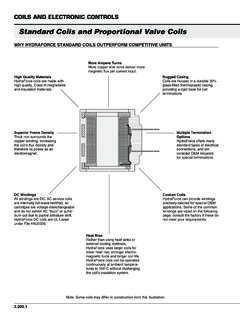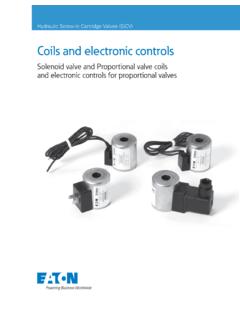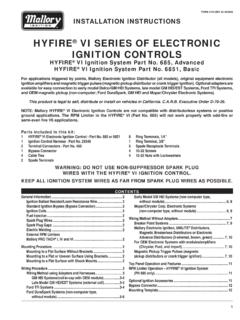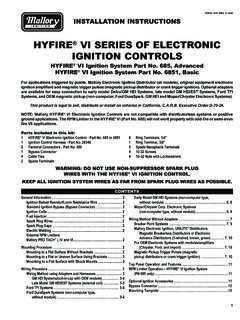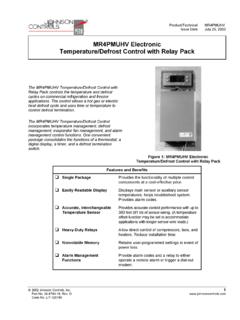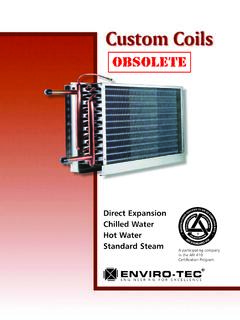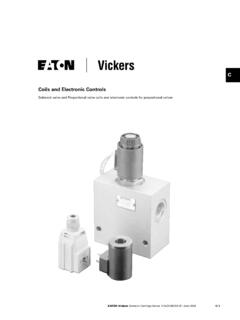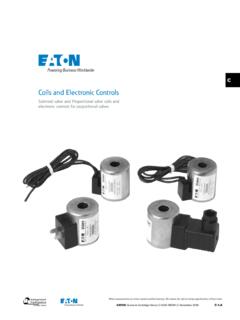Transcription of Steven T. Taylor Changeover Controls Coils
1 ASHRAE JOURNAL AUGUST 201766 COLUMN ENGINEER S NOTEBOOKS teven T. TaylorBY Steven T. Taylor , , FELLOW ASHRAEC hangeover Controls & CoilsSystems such as radiant floors, radiant ceilings, and chilled beams are often designed to have both heating and cooling capability and thus must have connections to both the hot water and chilled water systems. This month s column addresses how to design the Changeover Controls that manage the switch from one hydronic system to the other. Also addressed is the use of Changeover Controls to allow a single coil in an air-handling or fan-coil system to provide both heating and cooling, a design option that can reduce both first costs and energy costs.
2 Changeover Controls The primary concern with piping two hydronic sys-tems together is water from one system mixing with that of the other. Occasionally, there are two incompatible water treatment regimens used in the two systems (such as glycol in one system and not the other) which might preclude any mixing, and thus Changeover piping is not possible without adding a heat exchanger. But more com-monly the concern is sending hot water (HW) into the chilled water (CHW) system and vice versa, thus nega-tively impacting temperature control of adjacent Coils and increasing load and energy use at the HW and CHW plants. Three Changeover control designs are shown in Figures 1 to 3 and discussed below.
3 All three designs include features to minimize the chance of crossflow between the HW and CHW systems. Figure 1 includes two 2-way modulating control valves on the HW and CHW return connections and a 3-way* two-position valve on the supply connections. Valve actu-ators are spring return or electronic fail-safe type with their normal position shown as NC (normally closed) or NO (normally open), defined here as the position of the valve when there is no power to the actuator. Non-fail-safe actuators could be used with some additional wiring changes to power the valves to the desired posi-tion, but fail-safe actuators make the design simpler and more resilient, , if power to the control panel feeding the valves failed, the valves would fail to positions that ensure HW and CHW systems are not interconnected.
4 The 2-way valves would usually have different flow coef-ficients (Cv [Kv]) corresponding to the design flow rate and full-open pressure drop for HW and CHW needed to provide good valve authority in each mode. Since only one valve actuator is active (enabled with control power) at a time, a single analog output (AO) from the control system can be used to control both valves. Prior to chang-ing over from one mode to the other, both 2-way valves would be shut, allowing the coil/radiant system tem-perature to equalize with the air temperature to reduce the load and energy impact of mixing HW and CHW and vice versa during the Changeover . In many applications where there is a dead band between heating and cooling setpoints, this equalization occurs naturally.
5 Changeover is then initiated using the Changeover digital output (DO) from the control system and relay R-1. This causes the 3-way valve to switch from HW to CHW (or vice versa), provides power to (thus enabling) the 2-way valve for the associated mode, and disables power to (thus closing) the 2-way valve for the opposite mode. In any mode, includ-ing in a power outage, the 3-way valve is open to one of the two hydronic systems to ensure water from the coil/radiant system can expand and contract as temperature changes without creating excessive pressures. The design in Figure 2 is the same as that in Figure 1 except the 3-way valve is replaced by two 2-way valves Steven T.
6 Taylor , , is a principal of Taylor Engineering in Alameda, Calif. He is a mem-ber of SSPC and GPC 36.* This should be a near-zero leakage 3-way valve. Some 3-way char-acterized ball valves have significant leakage from one input port to the other; they should not be used for Changeover article was published in ASHRAE Journal, August 2017. Copyright 2017 ASHRAE. Posted at This article may not be copied and/or distributed electronically or in paper form without permission of ASHRAE. For more information about ASHRAE Journal, visit file is licensed to Steven Taylor Copyright ASHRAE 2017 ASHRAE JOURNAL67 COLUMN ENGINEER S NOTEBOOK with full-closed actuator end-switches (contact closes when the valve is fully closed).
7 Relay R-2 is provided to allow the HW supply two-position valve to be normally open, ensuring that water in the coil/radiant system can expand and contract with temperature changes in case of a loss of power to the Controls . This design costs more due to the extra valve, end-switches, added relay, and associated wiring, but it solves a potential problem with the design in Figure 1: as the 3-way valve changes position, a process that typically takes between 20 and 75 seconds, the HW and CHW systems are open to each other. Even when the systems have similar operating pressures ( , where elevations and expansion tank locations and precharge pressures are similar), there will inevitably be a pressure difference between the two at the 3-way valve, so crossflow will occur until the expansion tank pressure on the lower pressure system rises to equalize the two system pressures at the 3-way valve.
8 The volume of water transferred from one system to the other will be small where elevations and expan-sion tank locations and precharge pressures are similar, a prerequisite when using the Figure 1 design, but still will result in some inefficiency as HW and CHW mix. The design in Figure 2 solves this problem by essentially sequencing the valves using the full-closed actuator end-switches to ensure one valve is fully closed before the other is allowed to open. Figure 3 shows a relatively new product offering from a few manufacturers: a 6-way valve. The typical sequence is as follows: when the signal from the AO modulates from 2 to 5 Vdc, CHW flow is modulated from full open to zero flow; from 5 to 7 Vdc, all ports are closed (dead band); from 7 to 10 Vdc, HW flow is modulated from zero flow to full open.
9 This design provides all of the benefits of that shown in Figure 2 at a lower first cost and with less chance of failure due to simpler Controls and fewer moving parts. In the control dead band, all ports are closed, which could cause pressure issues due to thermal expansion of water in the coil/radiant system, but the valves include a pres-sure relief on one port to relieve excess pressure. The only major disadvantage of this option is that there is a limited range of valve flow coefficients (Cv [Kv]) available, so it is not always possible to find a valve that has the desired flow coefficient for both HW and CHW; one or the other is oversized or undersized. But it can be an ideal solution for small Coils , radiant panels, chilled beams, etc.
10 Changeover CoilsUsing Changeover piping is common for radiant floors, radiant ceilings, chilled beams, and the like. But it is not common to use Changeover Controls in air handlers and fan- Coils with a single coil serving as both the unit s FIGURE 1 Two 2-way modulating valves and 3-way two-position Modulating control Valve TypicalNCNCMAOCHWRNCCNOM2 HWS3-Way 2-Position control ValveChangeover SwitchDORR-124 VCoil/RadiantControl ValveCHWSMFIGURE 2 Two 2-way modulating valves and two 2-way two-position Modulating control Valve TypicalNCNCMAOCHWRNCNOM2 Changeover SwitchDORR-124 VCoil/RadiantControl ValveCHWSM24 VHWSR-2RM22-Way 2-Position control Valve With Full-Closed End Switch - TypicalFIGURE 3 6-Way Modulating ValveCHWRCHWSNONOHWRAOMNCNCHWSCCoil/Radi ant6-Way control




